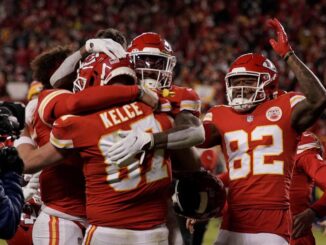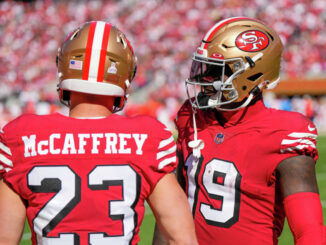
Joe Burrow, Ja’Marr Chase, and Tee Higgins. Those are probably the three names you think of when someone mentions the Bengals’ offense. It’s understandable when you see how this team has played over the last two seasons. Burrow has led one of the game’s most potent passing attacks that took them all the way to the Super Bowl last season.
The one question that lingered into this season was whether they could match this with an equally punishing running game. Early returns weren’t great. Through Week 8, the Bengals ranked 27th in EPA per rush. Their inability to run the ball allowed defenses to live in two-high shells and limit the explosive potential of their passing attack.
Things have changed through recent weeks though. Since Week 9 they rank second in EPA per rush, behind only the Eagles. A big part of this turnaround has been a change in their rushing philosophy. For one thing, they have taken to running much more out of shotgun. They have also diversified those runs and are now capable of attacking defenses in a multitude of ways.
So, what are these plays that they have been running? And how exactly do they all work? I’ve picked out six rushing concepts that we have seen through recent weeks and broken down how they work.
Split Zone
One play the Bengals have used a lot through recent weeks is split zone. This is very similar to inside zone, with one key difference. On split zone runs a player (usually a tight end) will work across the formation to block the backside edge defender. This play against the Titans is a great example of how it can work. As Burrow snaps the ball, tight end Mitchell Wilcox (#84) comes across the formation and walls off the edge defender, preventing him from getting to Perine in the backfield, who picks up a chunk gain.
Duo
To the untrained eye, duo looks a lot like inside zone. There are a few important differences to look for. The first is that duo is always run to the tight end side of the formation. The second is that the offensive line will create two sets of double teams. Unlike inside zone, the blockers will stay on these double teams rather than looking to climb to the second level.
The Bengals love to run duo and you’ll see them call it multiple times a game. It is a sign of how much they trust this offensive line, as duo is traditionally a play you run when you have the talent advantage in the trenches. This play against the Chiefs shows why they are right to do so. They generate a tonne of vertical push that keeps Perine clean and allows him to hit the hole with force..
Pin and pull
Pin and pull runs are increasingly popular across the NFL and it shouldn’t come as a surprise that the Bengals have incorporated them into their rushing attack. At its core, pin and pull runs function in a similar way to outside zone. The difference here is that any uncovered linemen will pull to the play side. So what does uncovered mean? This just means that they don’t have a defensive linemen directly across from them.
You can see how it works in practice on this play against the Panthers. Here the right tackle and tight end don’t have anyone directly across from them. As a result, they pull outside and act as lead blockers for the running back. Perine follows them downfield for a big gain.
Wham
Another of the gap scheme concepts that the Bengals like to run is the wham play. Wham comes in a number of variations, but there are a few simple components. The first is that it involves leaving an interior defender unblocked, who is picked up by a puller using a trap block. The running back is then free to attack the vacated gap, whilst offensive linemen can climb immediately to the second level.
On this play the Bengals are leaving Chris Jones initially unblocked. Tight end Mitchell Wilcox (#84) is then responsible for executing the trap block. This allows center Ted Karras to climb immediately to the second level and establish a sizeable running lane for Samaje Perine to exploit.
Power
Power isn’t a play that you’ll see the Bengals run very often, but it is one that they have added to their arsenal nonetheless. The concept can be run in a multitude of ways but in essence it is very simple. The backside guard pulls across the formation, with the running back following his inside shoulder.
On this play against the Steelers the Bengals are running a simple version of one back power with Samaje Perine. The gain is modest, but it once again demonstrates the number of options they have to attack opposing defenses.
Counter
Last but not least is one of my personal favourite concepts – counter. As with power, this can be run in a number of different ways but there are a few key features that help define it. At its core, counter involves a backside linemen pulling across the formation along with another blocker. This is often a guard and tackle combo but could also be a lineman and tight end. On rare occasions you will see the center and backside tackle act as the pullers.
On this play the Bengals have the guard and tight end pulling – this play is known as GY Counter. With the guard handling the edge rusher, the tight end is free to take on the free linebacker, giving running back Samaje Perine a clear path.
We also saw the Bengals run a different version of counter brilliantly against the Panthers. On this play they have the guard and tackle pulling, which is known as GT Counter. Joe Mixon does a great job of patiently following his blockers and he manages to get to the second level completely untouched by Carolina’s defense.
The Bengals’ rushing attack has been key to their success in recent weeks. The plays covered above provide a small window into the variety of concepts they are running, and you can fully expect them to keep adding wrinkles to their playbook as the season progresses.


